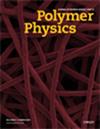应变对等规聚丙烯结晶物理胶凝的影响
3区 工程技术
Q1 Materials Science
Journal of Polymer Science. Part B, Polymer Physics
Pub Date : 1999-12-15
DOI:10.1002/(SICI)1099-0488(19991215)37:24<3512::AID-POLB12>3.0.CO;2-#
引用次数: 73
摘要
聚合物结晶的早期阶段可以看作是热可逆的物理凝胶,其中分子的连通性是由结晶引入的。通过动态力学实验研究了剪切应变对商品等规聚丙烯结晶早期阶段的影响。过冷熔体在短时间内(时间不超过100 s)发生大应变(γ = 300)的剪切蠕变,然后发生应变幅度(γ a = 0.01)的小振幅振荡剪切(SAOS)。施加的剪切强烈地加速了凝胶的形成;凝胶时间随应变的增加呈幂律递减。在晶体生长阶段施加的应变比在早期成核阶段施加的应变对凝胶化的促进作用强得多。对于快速凝胶,频率扫描是不可能的,需要探索新的凝胶点检测方法;在这里,我们建议从单频下的存储模量增长来估计凝胶点。发现G′总生长的10%的值是对凝胶点的一个很好的估计。高应变实验显示了应变增强结晶机制的复杂性,并揭示了剪切作用下结构发展的至少两个顺序阶段:第一阶段,晶体区域将分子连接成松散的网络;在第二阶段,在网络中进行强烈的结晶性生长。研究结果对于预测和调整非等温加工过程中的结构发展和连通性增长具有重要的工业意义。在应变下结晶早期阶段的形态学研究正在进行中,以探索控制凝胶过程的分子机制。本文章由计算机程序翻译,如有差异,请以英文原文为准。
Strain effects on physical gelation of crystallizing isotactic polypropylene
Early stages of crystallization of polymers may be viewed as thermoreversible physical gelation in which molecular connectivity is introduced by crystallization. Effects of shear strain on the early stages of crystallization of a commercial isotactic polypropylene are studied by dynamic mechanical experiments. Shear creep with large strains (up to γ = 300) on the undercooled melt for short times (the time did not exceed 100 s) was followed by small amplitude oscillatory shear (SAOS) at a strain amplitude (γ a = 0.01) for gel-point detection. The imposed shear strongly accelerates gelation; gel times decrease in a power law with increasing strain. Strain applied during the crystal growth stage enhances gelation much stronger than strain applied in the earlier nucleation stage. For rapid gelation, frequency sweeps are not possible and new methods for gel-point detection need to be explored; here, we propose to estimate the gel point from the storage modulus growth at a single frequency. A value of 10% of the total growth of G' was found to be a good estimate for the gel point. High strain experiments show the complexity of underlying mechanisms of strain-enhanced crystallization and reveal at least two sequential stages in the structure development under shear: at the first stage, crystalline regions connect molecules into a loose network; at the second, stage-intense crystallinity growth within the network proceeds. Results have industrial importance in predicting/tuning structure development and connectivity growth during nonisothermal processing. Morphological study of the early stages of crystallization under strain is underway to explore molecular mechanisms, which govern the gelation process.
求助全文
通过发布文献求助,成功后即可免费获取论文全文。
去求助
来源期刊
CiteScore
5.90
自引率
0.00%
发文量
0
审稿时长
2.1 months
期刊介绍:
Since its launch in 1946 by P. M. Doty, H. Mark, and C.C. Price, the Journal of Polymer Science has provided a continuous forum for the dissemination of thoroughly peer-reviewed, fundamental, international research into the preparation and properties of macromolecules.
From January 2020, the Journal of Polymer Science, Part A: Polymer Chemistry and Journal of Polymer Science, Part B: Polymer Physics will be published as one journal, the Journal of Polymer Science. The merged journal will reflect the nature of today''s polymer science research, with physics and chemistry of polymer systems at the heart of the scope.
You can continue looking forward to an exciting mix of comprehensive reviews, visionary insights, high-impact communications, and full papers that represent the rapid multidisciplinary developments in polymer science.
Our editorial team consists of a mix of well-known academic editors and full-time professional editors who ensure fast, professional peer review of your contribution. After publication, our team will work to ensure that your paper receives the recognition it deserves by your peers and the broader scientific community.

 求助内容:
求助内容: 应助结果提醒方式:
应助结果提醒方式:


